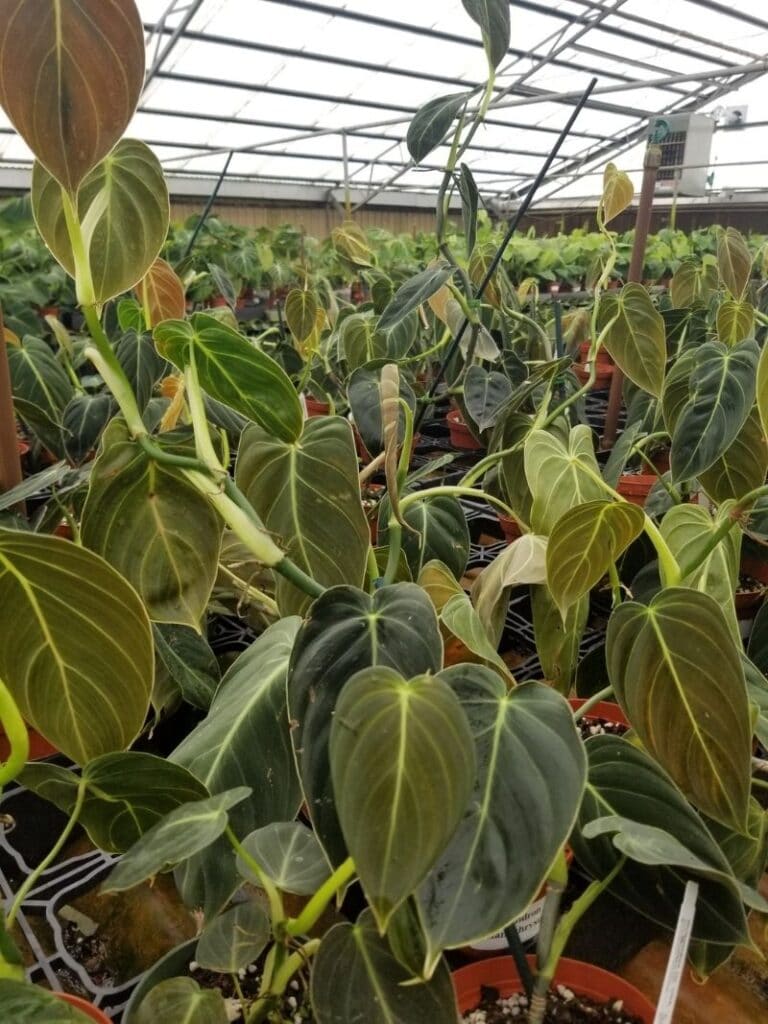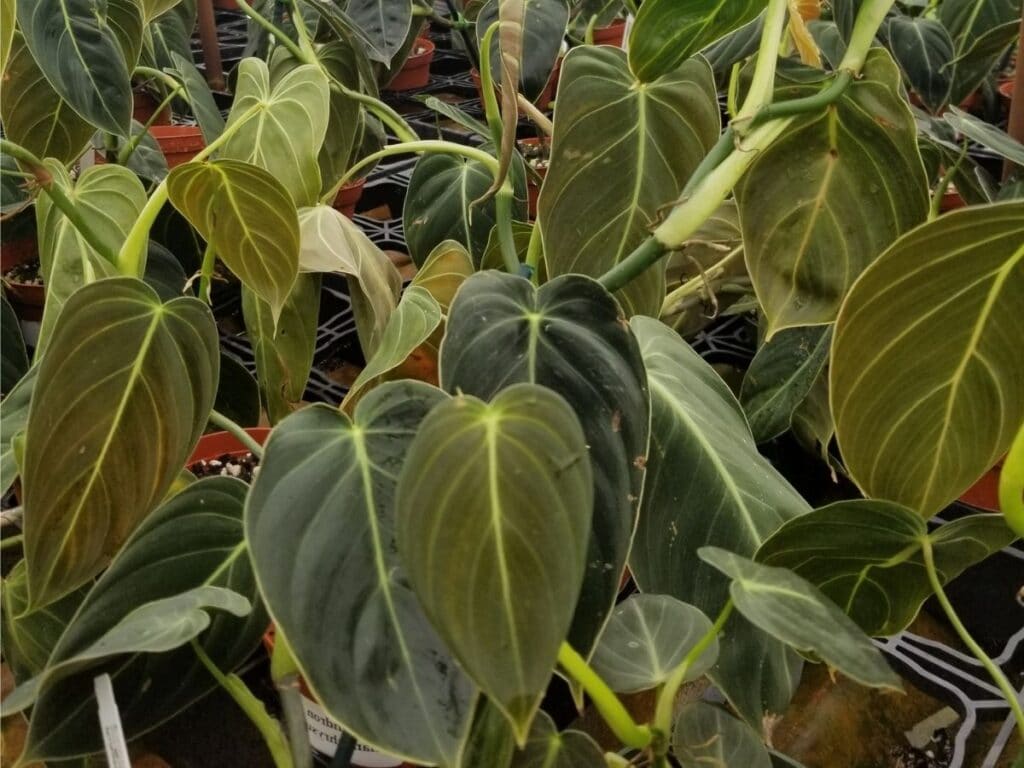Also known as the black gold philodendron, Philodendron melanochrysum is a wonderful aroid that has beautiful dark leaves with a contrasting pale midrib. It is a climbing species that can develop huge leaves if provided with support and a healthy growing environment.
These Philodendron plants thrive indoors with the right care and if you’d like to learn more about growing your own specimen, you’ve come to the right place.
What is a Philodendron Melanochrysum Plant?
P. melanochrysum is an aroid plant native to Colombia in South America. This species is a much sought-after houseplant and has been in cultivation since the 19th century.
Its scientific name translates roughly to black gold, which is a very appropriate description of its foliage color. It has velvety dark leaves that grow very large and change color as they mature.
Young growth is often a golden red color, darkening as it matures. The leaf venation is pale green and contrasts boldly, making for a rather dramatic-looking specimen. The leaves are typically about 10 inches (25cm) long on mature potted specimens.
Does Philo Melanochrysum Bloom?
This plant does occasionally flower but this is quite rare in indoor specimens. Since the inflorescences are relatively dull, you may wish to cut them off so the plant can put its energy towards growing more foliage.
Is Philo Melanochrysum Toxic?
This plant is potentially very dangerous if eaten due to the presence of calcium oxalate crystals. Contact with the lips, eyes, or sensitive skin can also cause irritation, so keep this plant away from pets and young children.

How to Care for Philodendron Melanochrysum Plants
Like most other aroids in the Philodendron genus, this plant is relatively easy to care for indoors. It is important to note that the plant can be quite sensitive to disturbance, particularly in the case of new growth and unfurling leaves. The foliage is also more likely to grow to its full-size potential if the plant is provided with support like a moss pole.
Read on for more practical advice on philodendron melanochrysum care – you’ll love growing this impressive indoor tropical plant.
Sunlight
In nature, this plant will be shaded by the other forest trees around it, but will likely receive some dappled light and weaker morning and afternoon sunlight. To recreate these conditions, position the plant where it can receive plenty of bright indirect sunlight, and perhaps some weak direct morning sunlight if you like.
Water
Water this plant when necessary, rather than trying to follow a fixed schedule. These plants are not drought tolerant, and should not be allowed to dry out completely and wilt. That being said, overwatering is a sure way to kill this species.
Feel the soil and water it through when it begins to feel dry to the touch at an inch or two (2.5-5cm) below the surface.
Temperature and Humidity
Average household temperatures are suitable for growing this species provided it is kept away from extremes of temperature near open windows or radiators for example.
This particular species of Philodendron appears to be more sensitive to dry air than others in the genus. It enjoys high humidity so providing a humidifier or growing the plant in a grow tent or similar environment will provide the best results.
Growing/Potting Media
This plant does not have any particular requirements and will grow successfully in the same mix used for other aroids and philodendrons. Philodendron melanochrysum grows best in a good quality potting mix for tropical plants but this can be improved by mixing in some orchid bark to create a coarse texture with plenty of aeration.
Fertilizer
Fertilize monthly when the plant is actively growing. A liquid fertilizer for houseplants is appropriate, but diluting the recommended dosage is advisable to prevent any harm. Remember to flush out the soil on occasion to remove any fertilizer that has accumulated around the roots.
Pruning
The black gold philodendron is not a particularly fast grower and will need very little pruning. You will only need to remove dying leaves as they are replaced with new growth. Use a sterilized cutting tool to prevent introducing any disease to the plant.
Common Pests and Plant Diseases
Keep an eye on your plant for pests like spider mites, scale, and mealybugs. Diseases like root rot and other fungal and bacterial conditions like leaf spot have been recorded. Limiting stress on the plant and providing it with good growing conditions and care is the best way to avoid health problems.
Propagating Philodendron Melanochrysum
The Internodes of this species are about 4 inches (10cm) long providing plenty of space for collecting stem cuttings. These should include a node and can be rooted in water, a potting soil mixture, or sphagnum moss. Air layering is another popular propagation technique for this species.
FAQs
Is Philodendron melanochrysum easy to care for?
Philodendron melanochrysum is generally considered to be moderately easy to care for, but it has specific requirements to thrive.
How do you get big leaves in Melanochrysum?
To encourage larger leaves in Philodendron melanochrysum, ensure it receives bright, indirect light, keeps the soil consistently moist, and provides regular fertilization during the growing season.
Is Melanochrysum a slow grower?
Philodendron melanochrysum is generally considered to be a moderate to fast grower under optimal conditions. However, its growth rate can vary depending on factors such as light, temperature, humidity, and overall care.
Does Melanochrysum need humidity?
Philodendron melanochrysum prefers high humidity levels to thrive. Providing adequate humidity, either through regular misting, using a humidifier, or placing the plant on a humidity tray, can help prevent leaf browning and encourage healthy growth.
Is Melanochrysum a climber or crawler?
Philodendron melanochrysum is a climbing plant by nature. It produces long, aerial roots that allow it to climb and attach to supports such as trees or moss poles. However, it can also be trained to trail or hang if provided with suitable support.
What is the difference between Philodendron Micans and Melanochrysum?
Philodendron micans typically has smaller leaves with a bronze to green coloration and a trailing growth habit. In contrast, Philodendron melanochrysum has larger leaves with a deep green coloration and a climbing growth habit.
Is Philodendron Melanochrysum rare?
Yes, Philodendron Melanochrysum is considered rare and highly sought after by plant enthusiasts. Its distinctive velvety leaves with golden veins make it a prized addition to any collection.
See more philodendron species and cultivars you can grow.
References
Reference list
- Royal Botanic Gardens. Philodendron Melanochrysum
https://powo.science.kew.org/taxon/urn:lsid:ipni.org:names:87882-1
- Tulane University. Oxalate Plant Poisoning
https://tmedweb.tulane.edu/pharmwiki/doku.php/oxalate_plant_poisoning
Close
*image by khairil77/depositphotos







